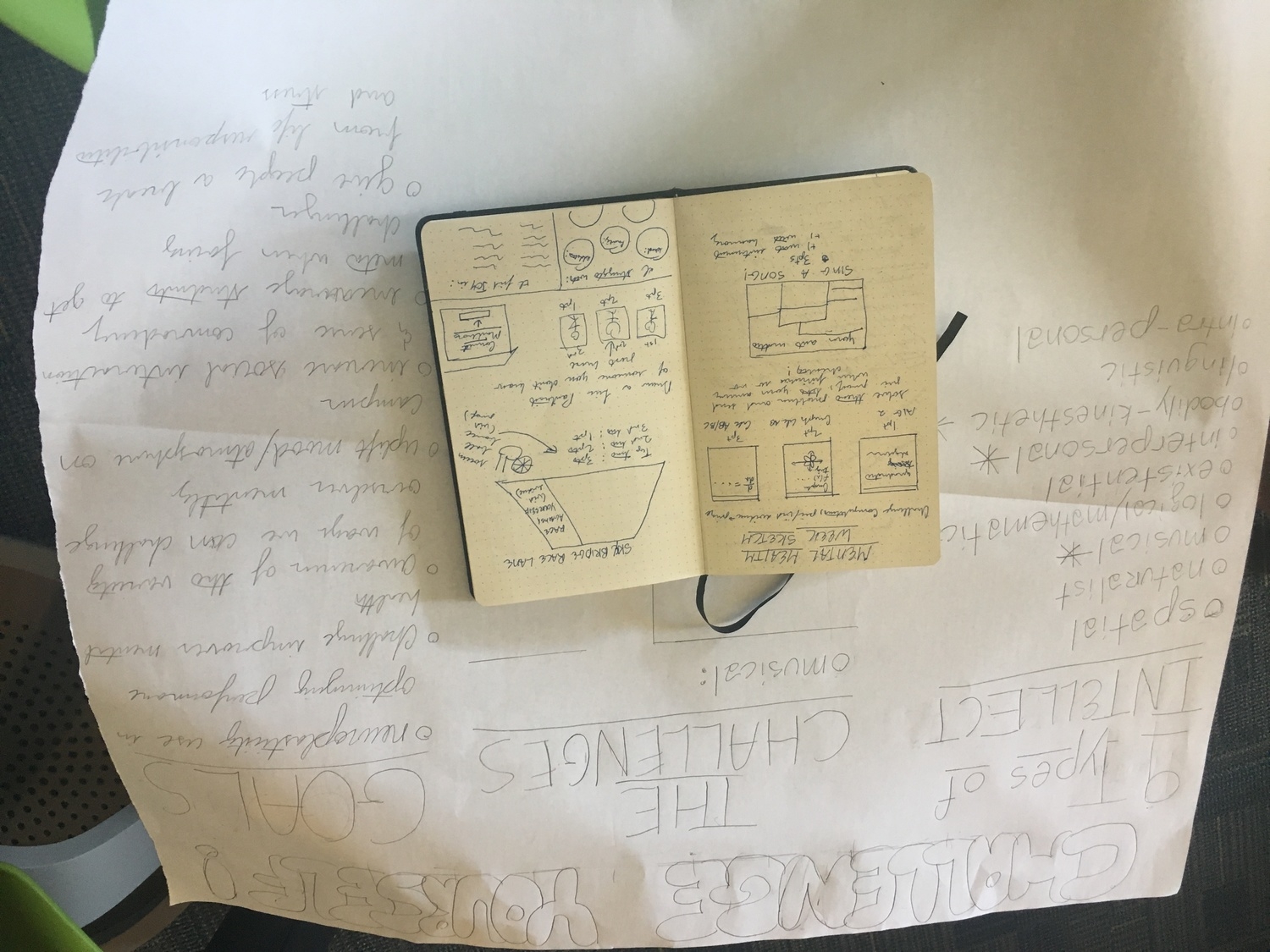When envisioning NUVU and the design studio, I see planks of wood, yellow screwdrivers, and sharp Exacto knives. I hear the loud rumbling of the laser cutter. I expect to be wearing protective glasses as I engineer a new device or piece of architecture. Neuro Week and Neuroplasticity as a class, although just as much of a design studio as Engineering, was nothing like those expectations. Its focus was to build interactions between and within our peers’ minds rather than to build something tangible. Don’t get me wrong, we used that laser cutter, and I built a wall, but the project was incomplete until people participated. These activities that we conjured up through research and background knowledge acknowledged the types of intelligence as defined by Dr. Gardner’s theory of multiple intelligences, challenging the student’s ideas of intellect that usually was based on numbers like GPA and test scores.
I facilitated a few things going into our project. For one, I proposed challenge week to start. I was inspired by Dr. Lara Boyd, an expert in the field of neuroscience, who told us that one of the most effective ways to maximize the neuroplasticity in our brains was to challenge ourselves. Taking that idea, I decided to integrate it with a theory I had knowledge of for a while, Dr. Gardner’s theory of multiple intelligences. Gardner’s theory pushed the traditional view of intelligence to have a larger range. Gardner argued that the IQ test was too limiting to the current and potential level of intelligence a person could reach. Taking this idea, I proposed challenges that catered to each type of intelligence: interpersonal, intrapersonal, spatial, naturalistic, logical/mathematical, musical, existential, linguistic, and bodily-kinesthetic.
We took the idea and ran with it, sketching out different possibilities and our roles in the project. I assigned myself the interpersonal challenge, a portion of the assembly presentation, and the class website/blog. Through these assignments, I realized a major struggle I had. It seemed that the biggest challenge of this class was that the students were the ones making the major decisions, not the teachers. However, for me, the challenge wasn’t to make the decisions, but rather to not make the decisions. I wanted to keep things rolling, getting everything done in a timely fashion. As Ms. Duke informed me, I tended to have an argumentative way of approaching things. It wasn’t that I wasn’t listening, but that I felt a need to get something done every class period. If I would have stuck to this mentality, our final product wouldn’t have had been nearly as thoughtful and intricate as it was. I had to learn to step back and think. What does this idea really do for the students? Are there ways I can improve or develop my idea? There always were. Once I accepted that the first idea was not always the best idea, I was able to allow myself to stray from the path and wonder about alternate possibilities. Throughout the process, I drew out ideas, erased those ideas, and improved those ideas multiple times. My challenge developed over much feedback and class periods. I adopted a mindset of growth that could be applied to anything I wanted to accomplish, literally anything. Throughout this semester we researched topics relating to self-talk, mental health ideals, mediation, athletics, and academics. Although there may not seem to be a common thread, all these subjects tie together in that to excel a growth mindset is required. I found myself carrying this understanding into my other classes and extracurriculars, showing a lasting advancement of my brain.
Once we had established our project, the presentation and website were easier to form with a defined topic and goals. We were able to focus on the aesthetics of it and how we would publicize it to the student body and school faculty. This was important because we wanted to represent ourselves in a way that would pump up students for neuro week. Although I believe more could be done to raise awareness of the project (signs, mini-activities), I was proud of the presentation we produced and the guidance website I designed.
The goal of neuro week is to help students re-channel the stressful energy that comes with exams into activities that are enjoyable and fruitful. Through these challenges, students will broaden their horizons on what it means to be intelligent, and the wide spectrum of skills that can factor into intelligence. For example, in the interpersonal challenge, students are put in an unfamiliar atmosphere of communication. They are separated by a wall, and therefore can only interpret each other’s words. Furthermore, they must convey what they hear into something visual, a piece of art. Through this challenge, students will be exposed to different aspects of communication and observe how they perceive each other and the world around them.
I feel as though the activities sparked awareness of the variety of strengths students possessed rather than helping them improve upon their strengths. To improve this project, I think we would need to develop a tactic to spur and measure improvement. Long-term improvement is a process, so some major changes would have to be made to the project. A student might have to take challenges multiple times or reflect more deeply on their learnings. It would be helpful to have tangible evidence of change.
I’ve learned that I can expand my brains neuroplasticity in a number of ways over the course of this project. Each challenge completely varied from one another, displaying the range in types of intellect. This is an important concept to share with others because it can help people, especially students, learn about themselves through a different lens. They can discover their strengths and make them stronger, and their weaknesses and make them less weak. Many times students grow hopeless over the classic idea of intelligence, so it has an impact to declare that what defines intelligence is still and may always be up for question.
:rotate(0)/3w8qfrmh87n638bdxtas43sbc96g)
:rotate(0)/nplat-v2-assets/3w8qfrmh87n638bdxtas43sbc96g)
:rotate(0)/ow2ww2fqunatfqsgwertd3wx26c2)
:rotate(0)/cbhci4p2cbg716m51iyhyaltl54x)

